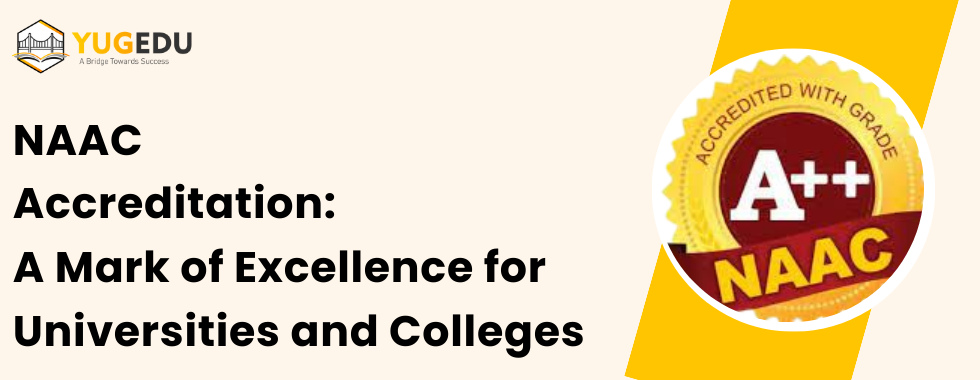
NAAC Accreditation: A Mark of Excellence for Universities and Colleges
The landscape of higher studies in India is extensive and diverse, encompassing universities and educational institutions that modify widely in terms of quality and recognition. Ensuring that those educational institutions maintain high requirements is critical for the students who attend them and the nation’s usual educational and monetary improvement. The National Assessment and Accreditation Council (NAAC) plays a pivotal role. NAAC accreditation is broadly identified as an indicator of excellence for universities and colleges, reflecting their commitment to quality education and continuous improvement.
In this blog post, we will explore deep insights into NAAC accreditation including Objectives, accreditation process, NAAC Grading system, Impact of NAAC Accreditation, and More.
What is the National Assessment and Accreditation Council (NAAC)?
The National Assessment and Accreditation Council (NAAC) certification is a measure to assess and then ensure the quality of education offered in top-notch universities or colleges nationwide. The University Grant Commission (UGC) has issued a decree stipulating that each university and college must get certification by the council known as the National Assessment and Accreditation Council.
The National Assessment and Accreditation Council (NAAC) accreditation is regarded as a standard for assessing a university or educational institution’s educational excellence. Students are willing to seek the quality education offered nationwide, thus the NAAC rating of an institute can be regarded as a guide when selecting one.
The quality of education from a university or a college can be proved with the improvement of NAAC grades. The benefits of the National Assessment and Accreditation Council (NAAC) accreditation help students nationwide achieve their higher studies in their respective domains at full potential by providing prospects to learn quality education and gain relevant skills required to develop critical thinking thoughts including problem-solving skills required to face all the intricacies or challenges of the domain. Universities or colleges that hold bad NAAC ratings need to improve their ratings.
Also Read: NAAC Accreditation: A Mark of Excellence for Universities and Colleges
The objective of the National Assessment and Accreditation Council (NAAC)
- To establish quality as the primary determinative for higher education nationwide in India by combining internal and external quality assessment, marketing, and sustainability programs.
- To encourage the quality education landscape for the promotion of quality in education and research in esteemed universities or colleges nationwide.
- The council is to undertake quality education research, training programs, and consultancy.
- The National Assessment and Accreditation Council (NAAC) is responsible for collaborating with other stakeholders of higher-quality education for quality education, sustenance, and promotion.
- To serve as a statutory authority to establish, carry out, and uphold the norms and standards.
- The council is responsible for offering quality assurance with recognition in universities or institutes.
- To recognize the needs and finance the sectors that are deemed priority.
The NAAC Accreditation Process
The rigid, multi-layered NAAC accreditation process is meant to ensure that recognized universities and colleges meet the highest possible levels of quality. The procedure consists of:
- Institutions seeking NAAC accreditation should submit the Institutional Information for Quality Assessment (IIQA) provides detailed information about their administrative and academic structures.
- A Self-Study Report (SSR) is a detailed document created by the concerned university and college that covers various aspects including teaching-leaning processes, research, student support, and educational infrastructure.
- A team of NAAC experts will visit the respective universities or institutions to validate the claims in the Self-Study Report (SSR).
- The National Assessment and Accreditation Council (NAAC) grants its accreditation to the concerned university or college valid for a specified period.
NAAC Grading System
The National Assessment and Accreditation Council (NAAC) provides a grading system to universities and colleges that range from A++ to C, with A++ being the highest grade denoting exceptional standards of quality. The grades are:
- A++ (3.51 - 4.00): Outstanding
- A+ (3.26 - 3.50): Excellent
- A (3.01 - 3.25): Very Good
- B++ (2.76 - 3.00): Good
- B+ (2.51 - 2.75): Above Average
- B (2.01 - 2.50): Satisfactory
- C (1.51 - 2.00): Average
- D (≤ 1.50): Not Accredited
The Impact of NAAC Accreditation
- NAAC is responsible for assuring the quality of education by providing accreditation to the university or educational institution.
- NAAC takes care of assisting universities or colleges with financial aid from the government and its departments. Several government agencies consider NAAC accreditation as a criterion for granting accreditation to universities and colleges.
- Universities or educational institutions that hold accreditations from the National Assessments and Accreditation Council (NAAC) gain a competitive edge in attracting students and faculty from all around the globe by providing quality education. NAAC accreditation ensures a great reputation for the university and the college.
- NAAC-accredited universities and colleges tend to provide better placement, as employers consider the value of graduates from such universities or educational institutions. Companies or organizations prefer to hire candidates from accredited universities or colleges nationwide.
- Universities and colleges hold accreditations from the National Assessment and Accredited Council (NAAC) promotes accountability and transparency in educational operations.
Also Read : Online B.Tech & Engineering Degrees Without Entrance Exams: A flexible Future for Tech Aspirants
Top NAAC-Accredited Universities Nationwide
However, there a thousands of NAAC-accredited universities nationwide. However, we have mentioned a list of top NAAC-accredited universities nationwide:
- University of Hyderabad
- Jawaharlal Nehru University (JNU), New Delhi
- Indian Institute of Science (IISc), Bangalore
- Banaras Hindu University (BHU), Varanasi
- Jadavpur University, Kolkata
- University of Delhi
- Anna University, Chennai
- Savitribai Phule Pune University, Pune
- University of Mumbai
- Aligarh Muslim University (AMU), Aligarh
- Amrita Vishwa Vidyapeetham, Coimbatore
- Bharathiar University, Coimbatore
- Panjab University, Chandigarh
- Birla Institute of Technology and Science (BITS), Pilani
- Osmania University, Hyderabad, and More.





